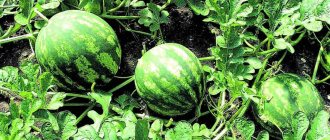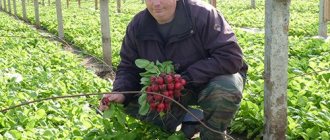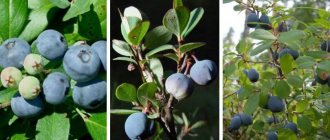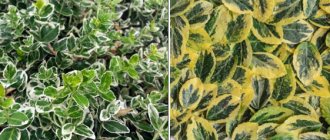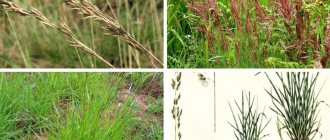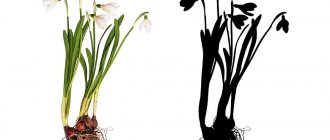Features of growing watermelons in Siberia
The peculiarity is that the summer is too short. You need to grow a plant in a short period of time. That is why the early ripening varieties are selected, and the method of planting is seedlings. The period between spring frosts and autumn colds is about 90 days. This time is enough for early species.
Seeds are sown in mid-spring, seedlings are planted in early summer, and the fruits can be harvested in mid- or late-summer. Summer in Siberia is hot; temperatures were recorded at +35 degrees Celsius. The season can also be rainy. Even if a gardener purchased early watermelon seeds, if there is heavy rainfall, the berries will not have time to ripen.
In Siberia, the years for growing melons and melons are different: productive and lean. However, in bad years, residents of Siberia find a way out - they salt or sprinkle unripe berries with sugar. They are used to make jam or prepare candied fruits.
Landing rules
Knowing how to plant watermelons in the ground, you need to remember that the quantity and quality of the future harvest directly depends on the fertility and looseness of the soil.
Therefore, the next stage of preparatory work begins with the selection and preparation of a site for this melon plant. The place for planting melons should be well lit by sunlight, protected on all sides from gusts of cold wind and be fertile.
Advice! The best soil for growing melons is sandy or sandy loam, into which high-quality humus was added during autumn digging (at least 1-1.5 buckets per m2).
When growing watermelons, you need to remember the rules of crop rotation - watermelons (like other melons) can be grown in the same place once every 5 seasons. The best predecessors for them will be: tomatoes, potatoes, any vegetables and green manure from the cruciferous family, as well as all representatives of the legume family.
- In the spring, when preparing the beds, mineral fertilizers are added to the soil: 1.5 tsp per 1 m². potassium salt, 1.5 tbsp. l. superphosphate and 1 tbsp. l. ammonium sulfate. The correctly selected composition of the mineral supplement activates the growth and development of the vegetative mass of watermelons and promotes better formation of ovaries.
- To plant the seed, planting holes are dug into which 1.5-2 liters of water are poured. After the water is absorbed, a nutrient substrate consisting of humus, wood ash, complex mineral fertilizer and peat is placed at the bottom of the pits, leveled and watered again. When the moisture is absorbed, 4-5 hatched watermelon seeds are placed in each hole, and they are covered with a layer of earth 3.5-4.5 cm thick on top.
- After the young plants have 2-3 true leaves, of all the plants grown in the hole, the strongest one is left, and the rest are removed.
- When growing this plant using the melon method, the seeds are planted in separate peat cups, together with which they will subsequently be transplanted to a permanent place. The cups are filled with nutrient substrate, the soil is moistened and the seed is planted. The seeds need to be buried 2.5-3.5 cm. The top of the container is covered with polyethylene and placed in a warm place (where the temperature is around 22-24°C). At night the temperature can be reduced to 19-20°C.
- After the first shoots appear, the film can be removed and the room temperature reduced to 17°C for 3-4 days. This is done so that the seedlings do not begin to stretch upward too much. Then the temperature is raised again.
- The soil in the cups must be constantly moistened so that the watermelon shoots do not begin to dry out. These plants need good light and warmth to grow. 7-10 days after the sprouts appear, they should be fed with nitrogen-phosphorus fertilizer.
- 7-9 days before transplanting to a permanent place, watermelon seedlings begin to be hardened, first by taking them out into the fresh air for half an hour, gradually lengthening the time spent outside.
The best varieties for growing in Siberia
In this area, it is possible to grow a large berry weighing about 15 kg only in a winter garden. Since the plant will have time to put out green tops in a short summer, but as soon as the cold weather sets in, everything will die, and you will not get a harvest. Small watermelons weighing 4 kg will ripen perfectly, especially with proper care.
When choosing a variety, pay attention to the following signs:
- berry weight (no more than 4 kg);
- precocity;
- homeland (place of selection).
Ogonyok
Every melon lover grew the Ogonyok variety of watermelon on his plot. It was brought out back in the 50s of the 20th century. Today, new varieties of crops are becoming popular, and this one is gradually being replaced.
Characteristics of the Ogonyok variety:
- whip 1.7 m long;
- leaves are small;
- berries in the form of a green ball;
- the weight of one fruit is about 2 kg;
- the pulp is orange-red, sweet;
- The seeds are small.
If you do not monitor the number of ovaries on one plant, then the watermelons will grow very small - about the size of an apple, but this will not change the taste, it will still remain sweet and juicy. The skin is thin and not suitable for transportation at all. Ogonyok fruits are stored for about a week. The first fruit can be picked 2.5 months after germination.
In the video below, watch a review of the Ogonyok variety of watermelon grown in Siberia:
Sugar baby
The variety has another name - Sugar Baby. Brought out by French breeders many years ago. Now known in many countries. In appearance it is very similar to Ogonyok, the only difference is the size of the berries, they can reach 5 kg. The flesh of a ripe Sugar Baby is red, maybe pink. The skin is thin, ripens 2.5 months after the formation of the ovaries. It does not spread its vines and grows compactly.
Siberian giant
It is a hybrid of melons, self-pollinating. Grows in greenhouses and in open soil. As a result, a rich harvest grows, and the plants can withstand cold and drought. The weight of one berry can reach 6 kg. The pulp is tasty, aromatic, red in color. The seeds are small.
The variety was developed relatively recently, so there is little information about it. There are also dissatisfied reviews from gardeners. The main mistake of Siberian summer residents is not rationing the harvest. This variety requires that no more than 3 ovaries be preserved on the plant.
Beijing Joy Peasant
This variety is a hybrid, the first harvest can be obtained 100 days after the formation of the ovaries. It has excellent transportability, the fruits are elongated with stripes. The weight of one reaches 8 kg.
Due to the large berries, more than 2 fruits should not be left on one plant. The skin is thick, the pulp is sugary. The seeds are small in small quantities. Can be grown in open soil, but it is better to plant in a greenhouse. After harvesting, the berries do not spoil, but ripen.
Gift to the North
Ripens within 80 days after the formation of the ovaries. Grows in open areas, protected from drafts. One fruit under good conditions and care reaches 10 kg. The pulp is sugary, of excellent taste. The hybrid variety is stored for a long time and tolerates transportation well. You should always keep covering material on hand to protect the variety from rain and cold weather. The harvest must be rationed.
Watermelon varieties for breeding in the Urals with descriptions and characteristics
When choosing a watermelon variety before planting, you should pay attention to the weight of the fruit - it should not exceed 5 kg, otherwise the watermelons simply will not have time to grow to their true size, not to mention acquiring taste characteristics. To grow in the conditions of the short Ural summer, watermelon varieties should be selected that are zoned with short and super-short ripening periods. In normal weather in the Urals, these varieties will be able to produce a harvest after 65–80 days
Under normal weather in the Urals, these varieties will be able to produce a harvest after 65–80 days.
It is better to buy planting material and do it at specialized points. Self-harvested seeds can be obtained from an unknown hybrid variety; it will not be possible to obtain watermelons with the supposed parental characteristics from it.
There are several specially bred watermelon varieties for cultivation in the Urals.
Ogonyok
This watermelon ripens in 75–85 days, which allows it to be classified as an early one. Thirty-day-old seedlings of the Ogonyok variety in the Urals are planted in open ground in June, which allows harvesting at the end of August. The Ogonyok fruits themselves have a spherical shape, black-green color, thin crust, and bright red flesh. Ball fruits can grow up to 2 kg in weight. True, the weight of the fruit largely depends on the summer Ural weather - the colder it is, the less watermelons will weigh. The variety can be grown in a greenhouse and in an open street garden. Ogonyok's plants are not afraid of occasional drops in temperature.
The watermelon variety Ogonyok has small (2 kg) spherical fruits of black-green color.
Gift to the North
An early hybrid variety can produce fruits weighing up to 10 kg. They are smooth-barked, green in color, with a broken dark pattern of lines. Their soft core is crispy and juicy, high in sugars, and has a reddish tint. The variety is characterized by good transportability, disease resistance, and the ability of the crop to bear fruit even during periods of severe drought.
The watermelon variety Gift to the North produces fruits weighing up to 10 kg
Skorik
The name of this variety eloquently indicates the main advantage - accelerated ripening of fruits. The fruits of Skorik are small, spherical, thick-walled, with a dark green rind and small seeds. They are distinguished by excellent keeping quality.
The Skorik variety is characterized by rapid ripening of fruits, which are well stored and transported
Crimstar
The ripening of the fruits of this watermelon in the open Ural soil occurs 2 months after planting. The variety is noted as high-yielding. Its fruits are large (about 9 kg), with a strong concentration of sugars.
Krimstar is a high-yielding variety that produces large (up to 9 kg) sweet fruits
Sugar baby
An early watermelon variety, the plants of which are distinguished by their unpretentiousness to cultivation conditions. For this reason, the variety is loved by many experienced summer residents. At the same time, the taste of its fruits is known and appreciated throughout the world. Despite their small size (1.5 or 2 kg), they have very sugary, bright red flesh. The fruits of this variety are ideal for pickling.
Sugar baby is easy to care for and produces small (up to 2 kg) sugary fruits
Ultra early
An early ripening watermelon variety with limited development of lateral stems. Therefore, the varieties of vines are compact and save land space. Which is very convenient when there is a shortage of it on the site. Round fruits with a dark green rind and dark stripes can gain weight up to 4–6 kg. The soft part is juicy, sweet, red.
The ultra-early variety is distinguished by the compact formation of vines on the plants; the fruits weigh 4–6 kg
Siberian
This variety was created by scientists at the Ural Laboratory and was intended for the climate of Siberia. It is characterized by early fruit ripening. Plants of the variety are adapted to short-term temperature fluctuations, as well as to a decrease in temperature to 4–6 °C at the time of germination and leaf regrowth. The fruits reach a weight of 5 kg, have a sweet and crumbly pulp with a small amount of seeds.
Watermelons of the Sibiryak variety are resistant to short-term temperature changes
Crimson Sweet
According to some gardeners, this variety of melon plant is considered the best for growing in the Urals for several reasons. Firstly, it is early, and secondly, the characteristics of the fruit are quite suitable for obtaining them in this climate. They can grow up to 10 kg. They are distinguished by their round shape, smooth surface, and very sugary pulp. Thus, the name of the variety translated into Russian means Raspberry Sugar.
The Crimson Sweet watermelon variety is excellent for the Ural climate; the round fruits grow up to 10 kg
Growing conditions
Growing melons and melons in Siberia is not easy, but if you approach the matter responsibly, every summer resident can get a large and tasty harvest.
Ideal timing for planting seeds
If you decide to place planting material directly in open ground, then this should be done in the last days of spring. Seeds germinate in about 7 days, so sprouts will form by the time it gets warmer in Siberia. If you start using covering material, you can sow in mid-May.
As for seedlings, they are planted in open soil or in a greenhouse from June 10 to 15, and the seeds themselves for seedlings from April 23 to May 1.
Planting seeds for seedlings: step-by-step diagram
Large varieties with a long ripening period or early ripening ones are grown using the seedling method in order to get the harvest as early as possible.
To grow melons, you need special nutritious soil; you can buy it in the store or make it yourself. In the garden you need to take vermicompost (the result of rotting organic residues). It is a red-colored substance located under leaves, tops and other debris.
People call vermicompost humus or compost.
You will need 1 part chopped straw and 3 parts humus. The nutrient substance for growing seedlings is ready. In Siberia, it is not possible to wait for the seedlings to get used to the soil after transplanting, so they need to be grown without picking - directly in large containers.
Watermelon has a root in the form of a long rod, which cannot be damaged during transplantation. The containers should be large, thanks to this the seedlings develop well. The roots of the melon crop grow much faster than the above-ground part. At the age of 1 month they reach 0.2 m. The pot should be taken at this depth.
Algorithm for sowing seeds for seedlings:
- Prepare planting material. A couple of days in advance, determine the seeds for germination: wrap in gauze moistened with water and place in a warm place (about +30 degrees Celsius). Before doing this, soak the seed in hot water for a couple of minutes. Thanks to these procedures, the seeds are disinfected and softened, and accordingly the sprouts appear much faster.
- Fill the container with prepared nutrient soil, leaving 50 mm to the top.
- Water it. If the soil has subsided a little, add more mixture.
- Place 2 seeds in each container and remove any weak shoots.
- Add another 30 mm of soil on top, do not water.
- Apply mulch in the form of dried grass or straw.
- Place the containers in a warm place (up to +30 degrees Celsius).
Caring for seedlings and preparing for planting
Pots with emerging shoots are placed on a windowsill facing south. If there is not enough sun and heat, then phytolamps are used. Watermelons take up a lot of space, so be realistic about the area you have. 5 plants grown in good conditions are much better than 20 plants living in crowded conditions and inconvenience.
It is necessary to water the seedlings as soon as the soil dries out. If you used a nutrient mixture with humus, then there is no need to fertilize the seedlings additionally. 7 days before planting, you need to harden the plants: take the pots outside every day. You should start with 1 hour, then increase the time.
By the time the watermelon is transplanted, the seedlings should have 4 leaves.
Transplanting seedlings into open ground
Melon crops occupy a large area. Watermelons are planted at a distance of 1 m from each other. The area should not be shaded by bushes or trees. In thickening areas, productivity decreases.
The ideal place to grow watermelons is an open, raised area. Siberian summer residents know that it is better to use boxes or warm beds. In this case, watermelons are raised above the soil, placing dry tops, branches, logs or grass under them.
Do not use manure, droppings or other organic matter to create warm beds.
Melon crops need loose soil so that the root system is well fed with fertilizers and water. Do not add large amounts of sand. Instead, you can use sawdust, bark, straw, etc. Various materials are suitable, which quickly rot and turn into fertilizer.
The soil for planting melon seedlings in Siberia is prepared as follows:
- scatter natural leavening agents over the soil;
- for every 1 sq. m add 1 tbsp. l. urea, 1 tbsp. l. superphosphate, 1 tbsp. l. potassium
This should be done 7 days before planting. To ensure that the soil remains loose after fertilizing, cover it with agrofibre or hay.
Algorithm for planting seedlings in open ground:
- Dig a hole the size of the container.
- Fill the pot with water and give the soil time to absorb it.
- Carefully remove the seedlings from the container with a lump of soil. If the pot is made of plastic, then it can be cut.
- Place the seedling in the hole and cover it with soil.
- Add water. If the soil has subsided, add a little more.
- Apply mulch. Read about soil mulching here.
Experienced summer residents cut plastic pots into several parts even before sowing planting material in them, after which they fasten the parts together with tape. It can be easily removed during planting. The main thing is not to disturb the root system of the melon crop; summer in Siberia is short, and there is no time to wait for the seedlings to recover and begin to grow again.
Rules for germinating watermelons
First you need to select suitable seeds. They must be large, full, without damage, and belong to varieties that are optimal for growing in a given area.
Important! It is advisable for residents of the northern regions to choose early-ripening and cold-resistant varieties; southerners can opt for later ones. Then there is a quality check in the following way
Add 1 tablespoon of salt to ½ glass of water and stir. The seeds are immersed in the resulting solution. Those left at the bottom are good for germination. They are washed with clean water and dried. Substandard floats are removed. If the seeds have not been treated, you will need to do this yourself to protect them from disease. The process is simple: first you need to prepare a solution of potassium permanganate at the rate of 1 g/100 g of water. Next, watermelon seeds are immersed in the resulting liquid for 20 minutes. Then they are washed again in clean water, preferably running
Then there is a quality check in the following way. Add 1 tablespoon of salt to ½ glass of water and stir. The seeds are immersed in the resulting solution. Those left at the bottom are good for germination. They are washed with clean water and dried. Substandard floats are removed. If the seeds have not been treated, you will need to do this yourself to protect them from disease. The process is simple: first you need to prepare a solution of potassium permanganate at the rate of 1 g/100 g of water. Next, watermelon seeds are immersed in the resulting liquid for 20 minutes. Then they are washed again in clean water, preferably running water.
Sprouted watermelon seeds
To saturate the seed with nutrients and speed up germination, you can use growth stimulants, for example, Heteroauxin. To do this, the drug is diluted with water in the proportion indicated on the package, and the seeds are immersed in it for 10 hours. There is no need to rinse them after this, just dry them.
On a note. Before germination itself, the seeds are soaked again, this time in hot water (45-50°C). This will soften the thick skin of the seeds.
After 10 minutes, the seed material is placed in gauze, folded several times. The fabric is placed in a flat container, for example, a saucer, and placed in a warm place. All that remains is to monitor the condition of the seeds and humidity: the gauze should not dry out. But there is no need to fill it with water. To reduce evaporation, cover the container with polyethylene.
If there are not so many seeds and there is enough time, you can further speed up the germination process by scarification. To do this, selected and calibrated grains are processed with sandpaper. More precisely, the nose of the seed wears off a little. This will make pecking easier.
Germination time
Note! To determine how long it takes for watermelons to sprout, you need to make sure that all preliminary steps have been completed correctly. The speed of germination depends on them
Provided that all of the above procedures were carried out correctly, the seeds will be ready for sowing in a week. Germination may be delayed if pre-soaking in hot water was not carried out. It is more difficult for a sprout to break through an unsoftened skin. Non-compliance with the temperature regime can also slow down the germination rate.
Watermelon seeds soaking
Melon growers who are seriously involved in growing watermelons install special systems that increase the temperature under the container with seeds from 20 to 50°C. Whether bottom heating is needed is something everyone decides for themselves. The seeds will need 20-30°C heat for germination.
Possible difficulties during germination
Seeds may not germinate in the following cases:
- Old and dried ones were selected. It is hardly worth waiting for shoots from low-quality material; you will have to purchase a new batch of seeds and start all over again;
- The temperature regime is not maintained. Perhaps the seeds are too cold and should find a warmer place for them. How many days after sowing watermelons sprout depends mainly on the temperature of the soil and air;
- No soaking was carried out. You will have to wait a little longer until the thin sprout breaks through the thick seed coat;
- Low humidity. If the gauze and the seeds in it are dry, you need to moisten them generously with water. Otherwise, you will have to sow not sprouted, but dry seeds.
Caring for watermelons in the open ground
If the soil is with mulch, then watermelons should be watered no more than 2 times in 30 days, with the exception of very hot days. Fertilizers are applied along with water; you can use a solution of mullein or mineral fertilizers. Spraying is done in calm weather.
Pinching is an essential part of care. Almost always they leave 2 lashes, all the stepsons on them are destroyed. This procedure should be done every week. Gardeners monitor the appearance of excess shoots and remove them in a timely manner. There should be 2-3 ovaries left on the central lash so that the watermelons are not too large and have time to ripen by the end of summer.
As soon as the ovaries reach 50 mm, it is necessary to pinch off the tip of the shoot. After the last greenery, 5 leaves are left. The berries are placed on boards so that they do not touch the ground.
Summer residents always need to remember that watermelon is a southern berry, so when growing it in Siberian conditions, you must follow the basic rules:
Weeds cause harm because they feed on all the beneficial elements that were intended for watermelons. The weeds are pulled out along with the roots. In the last period of the growing season, they stop loosening the soil.
In mid-summer, fertilizing with phosphorus and potassium will not hurt. Experienced Siberian summer residents stop watering a week before harvesting, but many descriptions say that the plant does not need water a month before harvesting. This is a misconception; plants need to be watered, especially on hot days. Without water, the berries become tasteless and small.
The peculiarity of Siberia is that watering depends on the weather; sometimes rains take care of everything and the summer resident does not have to water the plants at all.
When to plant watermelon seedlings?
Watermelon seeds for seedlings should be planted at the end of the third ten days of March and the beginning of the first ten days of April, from March 25 to April 15.
Important Also remember that by the time you plant the seedlings in the ground, they should be 25 - 30 days old
How to plant watermelon seeds for seedlings?
Before sowing the seeds in the ground, you need to soak them for 20 minutes in a dark pink solution of potassium permanganate.
Then the seeds need to be washed and wrapped in a damp cloth for further germination.
When the seeds hatch (usually 6 days), they need to be sown in peat pots filled with soil to a depth of 2 cm.
Soil for watermelon seedlings Soil for growing watermelon seedlings should consist of peat, humus and sand in a ratio of 1:1:0.5)
Watermelon seedlings
Pots with seeds should be placed on a bright window and germinated at T + 25 - 27 C, gradually reducing it to +20 C, watering only with warm water.
10 days after germination, mineral fertilizers are applied to the seedlings (Fertika, Sotka, Mortar). Repeat the next feeding after 10 days.
How and when to plant watermelon seedlings in open ground?
Watermelons are planted in open ground after June 15, when the threat of frost has passed.
If you plant watermelons under shelters, then you can plant seedlings in open ground starting from the 3rd week after germination.
The optimal ambient temperature is 15 -1 7 C.
How to grow watermelons in open ground?
Let's look at the main points in more detail.
Soil for planting seedlings
Before planting, add a bucket of humus, 50.0 mineral fertilizer, 2 cups of wood ash per 1 sq.m. to the soil.
How to plant watermelon seedlings in open ground
You need to remove the top of the peat pot and place the plant in the previously dug holes.
How to plant watermelon seedlings Planting pattern: in a row - 70 cm, between rows 1.5 m
Next, you need to pour water into the hole and cover it with soil, without deepening the root collar.
The planted seedlings can be covered with covering material and not removed until flowering and the onset of summer heat.
How to care for watermelon plantings
Watermelons need to be periodically loosened, weeded and fed:
- The first feeding is carried out two weeks after planting in the ground,
- 2nd feeding in the budding phase.
How to water watermelons?
Water the watermelons with warm water, 1 or 2 times a day, in large quantities.
Important!!! In order for the watermelons to be sweet and juicy, during the period when the watermelons begin to bear fruit, watering is reduced, and during the ripening period it is stopped.
Important! Despite the fact that watermelons are pollinated by insects, sometimes such pollination is not enough. Therefore, you can pollinate watermelons yourself, manually, by transferring pollen from male plants to female ones.
How to grow watermelon in a greenhouse?
The time for planting watermelons depends on how warm the room is. The optimal temperature is +25 degrees Celsius. Similar conditions are achieved at different times due to different greenhouses (film, polycarbonate, etc.).
In Siberia, seedlings are planted in film and glass greenhouses at the same time as in open ground. Polycarbonate greenhouses are especially common; plants are planted in them after May 20th. Melons are grown in greenhouses not in order to obtain a rich harvest, but so that the seedlings are protected from winds, cold and precipitation.
The only disadvantage of this method of planting watermelons is that a minimal number of insects fly into the greenhouse, so you will have to do pollination yourself.
Two methods of growing watermelons are suitable: seeds and seedlings. The soil for planting is prepared in the same way as when growing in open soil. The placement of seedlings is more compact: 0.7x0.7 m. Watermelons are grown on trellises.
If you planted seedlings during a period when frosts may still occur, then provide the young plants with additional protection. You can use boxes, agrofibre, paper, etc.
Plastic water bottles are excellent sources of heat and are placed around the greenhouse. During the day they are heated by the sun, and at night they give off heat to the plants. A similar technology can be used when growing melons and melons in open soil.
Preparing seeds for sowing
Seeds that are pre-selected and tested for germination are prepared for planting. To get strong and healthy seedlings, it is recommended to prepare the seeds before planting.
Preparatory activities:
- Disinfection. This procedure is aimed at preventing disease. The seeds are immersed in potassium permanganate (concentration 0.5–1%) for half an hour. Then dry it by spreading it on a cloth napkin.
- Warming up. The seeds are kept for half an hour in water heated to 45 °C. After this procedure, the seeds germinate better. The main thing is not to overheat them. The second option is to warm the seeds in the sun for a week. The heated seeds are immersed in Cytovit or Zircon (2 liters - 1 ampoule).
- Scarification. The essence of the procedure is piercing the seed shell. Germination accelerates significantly. The procedures are carried out 2-3 weeks before sowing.
- Soaking in nutrient solution. To increase yield, seeds are soaked in a solution of microelements. The solution contains manganese, boron, molybdenum. The concentration of the solution is 0.05. Exposure time – 16 hours.
- Germination. To make the seeds germinate faster, they are germinated by wrapping them in a wet cloth. Ambient temperature - +20–25 °C. The fabric is regularly moistened - it should not dry out. During the day, the top layer is removed several times for ventilation. As soon as the sprouts appear, sowing work begins.
Diseases and pests
Watermelons grown in Siberia are also vulnerable to diseases and pests. The most dangerous enemies of melons and melons:
- Powdery mildew. Symptoms: the appearance of white spots on the foliage and stems, leading to the death of the plant. If the disease is not dealt with, the problem will spread to the berries. Fighting powdery mildew: treating plants with colloidal sulfur or Topaz, Bayleton, Planriz products.
- Anthracnose. The disease appears due to high humidity in the greenhouse. Symptoms: yellow-brown or pink spots form. Fighting anthracnose: treatment with Bordeaux mixture or chemicals.
- Spider mite. Symptoms: the plant withers and curls, pests feed on watermelon juice. Pest control: folk infusions, for example, with tobacco and laundry soap, help.
Powdery mildew
Anthracnose disease
Spider mite
Professional chemicals can destroy a disease or pest. To ensure that the entire harvest does not go to waste, diseased specimens are disposed of.
Harvest and storage
Small-sized fruits ripen much earlier than large-sized varieties. The tail of a ripe berry is completely dry. The skin acquires a glossy hue, and the pattern becomes clearer. To be sure that the fruit is ripe, knock on it - you should hear a dull sound. Another sign is the presence of a yellow spot.
Early varieties with thin peels are not intended for long-term storage, so it is important to pick the berries on time. To collect watermelons, choose a dry day. The fruits are carefully placed in cardboard boxes and covered with paper on top.
Experienced gardeners from Siberia have come up with several tricks to preserve watermelon for as long as possible. Some store the berries in ashes, others wrap them in cloth or cover them with a layer of wax. In any case, the berries should be kept in a basement with excellent ventilation, temperature +3 degrees Celsius, humidity - about 80%.
At home, fruits will last longer if they are stored in a cool place and turned over daily.
Useful tips
Tips from experienced summer residents:
- Make an open bed only using black material; transparent films do not bring results.
- Make cross-shaped cuts in the material and plant the seedlings in them.
- Before planting, treat the seeds with a growth stimulant.
- When transplanting seedlings, take the root system along with a lump of soil.
- Use large peat pots.
- Do not over-water watermelons; too much moisture damages the roots.
Reviews from gardeners about growing watermelons in Siberia
★★★★★
Anna, 43 years old, agronomist, Barnaul. Ogonyok was planted that year.
A sufficient amount of harvest has been collected. I grew it in a greenhouse, I was afraid that it would freeze, since the summer in our city was not very warm. But I used the plastic water bottle method. As a result, I got: 15 plants, 30 fruits, but I don’t take into account the berries that we sampled. ★★★★★
Alexandra, 67 years old, pensioner, Yakutsk. For the first time in my life I decided to plant watermelons at my dacha.
I chose the Gift to the North variety. The description says that the fruit reaches even 10 kg. As a result, I grew 2 fruits on one plant, one weighing 4 kg. Of course, not what I expected, but I gained experience. This year I will plant a different variety of watermelon. Hide
Add your review
In Siberia, you can also grow such a heat-loving melon crop as watermelon. To do this, you need to choose the right variety and planting method. Particular attention should be paid to proper and regular care.
0
0
Copy link
What to do and how to grow watermelons if you don’t have a summer house?
If growing in a summer cottage is impossible, but you want to enjoy a ripe watermelon, then you can buy a watermelon at the market.
True, the price of early ripe watermelons is unlikely to be very low, but this variety will fully justify it!
Before you go to the market for a fresh delicacy, you need to know how to choose a ripe watermelon so that you don’t be disappointed at the table.
- Firstly, you need to take into account that watermelon is still a crop that ripens in August, so you shouldn’t buy the berry before it.
- It is best to purchase watermelons in a specially designated area - a market or a tent.
- The fruit should not be the most massive among its peers, but not the smallest. Medium-sized berries are preferable.
- The peel should be smooth, shiny, without dents, scratches or other damage. When choosing Kai watermelon, which is a striped variety, you need to focus on fruits with the most pronounced stripes.
- A yellow “bedsore” on the crust is required, that is, the place that came into contact with the ground when the fruit ripened in the garden.
- The stem of the watermelon should dry properly, this indicates the ripeness of the fruit.
- Many people know that there are watermelons and “watermelons”, the main difference of which is a wide circle in the place opposite the cutting. It has been scientifically proven that “ladies” watermelons are sweeter, so if possible, you should opt for them.
- And finally, the sound effect. When you click on the watermelon rind, a ringing, rather loud sound should be heard. If it is deaf, then the watermelon is unripe or its flesh is loose. Such fruit most likely will not be tasty.
After a watermelon is picked from the garden or purchased at the market, one should not forget about the need to thoroughly wash the rind under running water. That’s it, now the “berry” can be cut and served. Bon appetit!
